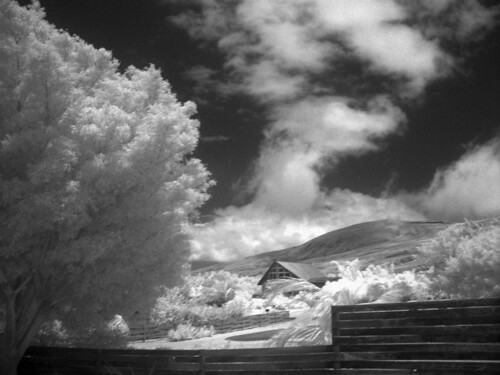But when I first started shooting infrared I found out that even back then, modernization had caught up with me and caused problems. The Canon EOS A2 body didn't use a sprocket wheel to count frames as you advanced film. It used a really nifty arrangement with a photodiode and an LED. "An LED" you ask? "Wouldn't that expose the film?" Of course not! The clever Canon engineers used an infrared LED, so black and white and color film aren't exposed to any wavelength they can't handle! How ingenious!
"But what about HIE?" Yeah, that was the problem. The 800nm IR LED exposed HIE right in the wavelength range it's the most sensitive. So a 35mm negative (24mm x 36mm) became somewhat shorter (roughly 18mm x 36mm) because a wide swath was blasted by the LED.
So I got an older Canon EOS body that had a sprocket counter. It worked great, but other handling issues with HIE made it less than attractive. Most films have what's called an "anti-halation layer" on the back of the film. It's a fancy way of saying, "This is here to keep light from spreading." The plastic medium used for film is an excellent light pipe. Once light gets in, it bounces around spreading itself all over the place. For films without the anti-halation layer, this makes for haloes around bright objects. (Yes, "anti-halation" means "no haloes".)
Because HIE is so insensitive to light overall, an anti-halation layer would've made it unacceptably slow and even harder to use. So Kodak skipped the anti-halation layer, and used the light pipe effect of the film to make it more sensitive to light. It worked! In direct sunlight I was able to shoot it as if it were an ISO 125 film. And without the anti-halation layer, infrared pictures had an etheral otherworldly feel to them that's hard to capture any other way.
But eventually enough was enough. Because there's no anti-halation layer, any exposure to direct light could easily expose a third of the roll. So you had to load the camera in a dark room or inside a dark bag. It also tended to go bad fast, so you had to get it developed quickly. Most labs wouldn't touch the stuff, not because it was particularly gross or anything, but because it was a pain to handle. So eventually I gave it up and quit playing.
Until I went digital.
The first digital camera I ever got, a Nikon Coolpix 950, turned out to have really good infrared response. This should come as no surprise to anyone familiar with CCD technology. CCDs are sensitive from about 400nm out to about 1100nm, with the bulk of their sensitivity being between 700nm and 1100nm. This region is also known as the near infrared. (Well, the very near infrared.)
Given that, almost all digital cameras should have phenomenal infrared response! True, but they don't. Because letting in all that infrared light would make for some really weird photographs. Rather than have people complain, digital camera manufacturers include an infrared blocking filter in most of their cameras. Some filters are more effective than others. The one in the 950 wasn't all that effective, so by putting an infrared filter on the lens I was able to do infrared photography with comparative ease.
The only catch is the 950 was only a 2.5 megapixel camera. Still, given the grainy nature of HIE, that's actually more information than I could ever get out of an infrared film picture.
Times change, new cameras come and go. The day came when my wife and I traded in all our 35mm film bodies for a digital SLR, a Canon 20D. Hot diggity! Here was a chance to do infrared with a real camera! Aaaaah, but it was not to be. The Canon 20D uses a CMOS detector. Between the detector and the IR blocking filter, it has practically no sensitivity at all beyond about 720nm. So when I tossed my infrared filter on the end of the camera, absolutely nothing happened. It was like having the lens cap on.
I gave up on the idea of infrared photography for many years. I tried with the Nikon Coolpix 5600, but it had response similar to the 20D. I really thought it was done and gone.
So I was a little intrigued to learn that the A650IS has decent infrared response, and even some response in the UV! On a whim I picked up one of the IR filters from work and held it in front of the lens. It could see! So when I got home I pulled out my trusty IR filter and tried a shot.

Success! The black sky, the bright white clouds, and the ghostly rendering of vegetation all indicated I was getting infrared response rather than UV. It looked almost exactly like an HIE picture, minus the haloes.
I haven't found a way to test UV response yet, but we've got some UV filters at work I can use to at least verify that the camera can see out there. That's next.
My first thought on seeing this picture come out was, "I can't wait to do infrared from the air!" Well, yes, but it probably won't happen. The IR response of the A650IS is good enough for tripod shots, but at 1/6 second at f/4 aperture, it's not fast enough to make decent handheld or KAP shots. The Nikon 950 would've done a better job. Scott Armitage, who makes the DuneCam KAP control and video downlink system, has had really good results with a Pentax Optio S4, which seems to have similar sensitivity to the Nikon 950 while providing a much higher resolution image.
So no aerial IR for me. But still, it's nice to have the option again on the ground.
Tom
No comments:
Post a Comment